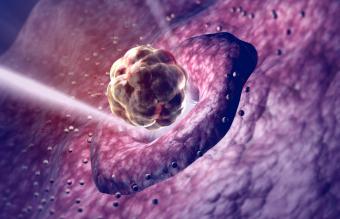
When you or someone you love is pregnant, it's important to watch out for signs of preeclampsia.
What Is Preeclampsia?
In books and online, you may hear preeclampsia called some different names. Its full name is Preeclampsia Toxemia. It's also known as toxemia, hypertensive disease of pregnancy, hypertension in pregnancy, or pregnancy-induced hypertension.
Preeclampsia is a tricky pregnancy problem because it only causes symptoms in the later stages - but those symptoms can be very dangerous.
In fact, in the last stages it's called eclampsia. Eclampsia is characterized by convulsions or seizures, extremely high blood pressure, preterm labor, coma, and sometimes death of the mother, baby, or both, all the more reasons why you need to be aware of the early signs of preeclampsia. Luckily, by catching preeclampsia early, you can avoid eclampsia altogether. It's also important to note that eclampsia is very rare. Only around 1 in 2,000 women will experience it because it is usually caught in the preeclampsia stage.
To learn more read:
High Blood Pressure and Pregnancy
What Are the Early Signs of Preeclampsia?
Signs you and your care provider should be watching for include:
- Being more than 20 weeks along in your pregnancy. Preeclampsia usually occurs after the 20th week.
- Elevated blood pressure.
- Excessive retention of fluids - also known as edema or bloating. Often this bloating will occur in the face and hands.
- Rapid weight gain but your diet and exercise routines haven't changed.
- Protein in your urine.
If you or your care provider notices any of the above signs, further tests will be conducted. It's important to have further tests even if high blood pressure is your only symptom. While high blood pressure alone does not indicate preeclampsia, it could indicate a kidney disorder or other problem. Most of the time, the biggest indicator of preeclampsia is that you have both elevated blood pressure and retention of fluids.
What Are the Later Signs of Preeclampsia?
The later signs can be characterized as symptoms caused by the development of untreated preeclampsia. Some of these signs and symptoms include:
- Headaches
- Vomiting
- Nausea
- Feeling dizzy
- Visual disturbances
- Upper abdominal pain - or a feeling of pain in your ribs on the right side of your body
The above are considered dangerous and advanced preeclampsia symptoms. If you have some of the early signs of preeclampsia and then develop any of these severe symptoms, it's important to call your care provider right away. If you can't find your care provider, a trip to the emergency room is your best bet. At this stage, untreated preeclampsia is a major problem. The next stage will be convulsions.
Other Risk Factors for Preeclampsia
While risk factors are not conclusive signs, they can be good indicators that you need to carefully watch for preeclampsia signs. Some currently known risk factors for preeclampsia include:
- This is your first pregnancy.
- You're a pregnant teen.
- You're a pregnant woman over the age of 35.
- You're pregnant with twins or multiples.
- A family history of preeclampsia.
- A family or personal history of hypertension, renal disease, or diabetes mellitus.
- You had preeclampsia during a previous pregnancy.
- You're experiencing a high stress pregnancy - this means that you're experiencing stress in your life, such as work or personal issues.
- Poor pregnancy nutrition.
Any of the above factors may possibly increase your chances of developing preeclampsia.
Causes of Preeclampsia
Preeclampsia is not widely understood. So far, research has failed to turn up any clear markers for what exactly causes preeclampsia to occur. Researchers think that a woman with preeclampsia has thinner than normal blood vessels. The extra thin blood vessels are caused by your uterus reacting unusually to the presence of the placenta.
To learn more about the current theories of what causes preeclampsia, visit The Preeclampsia Foundation or read Cause of Preeclampsia.
Preeclampsia Treatment
There are many treatment possibilities for preeclampsia. Some of the most popular include:
- Bed rest - although you should only rest in certain positions and no one is absolutely sure that bed rest is an effective treatment plan.
- Relaxation techniques.
- Magnesium sulfate injections given during a hospital stay.
To learn more read:







